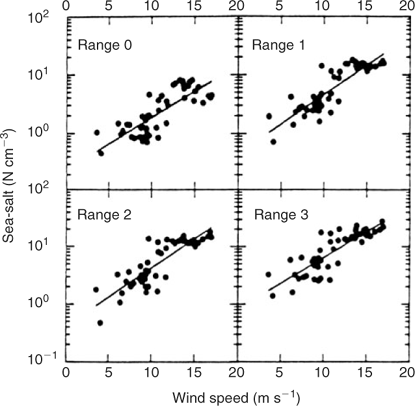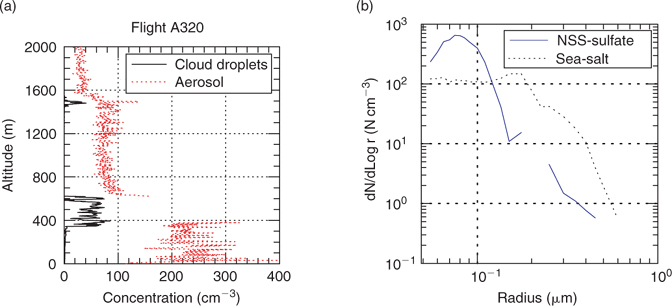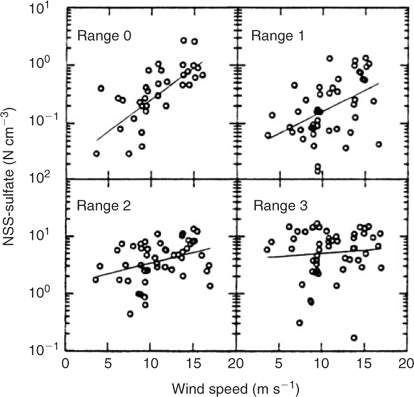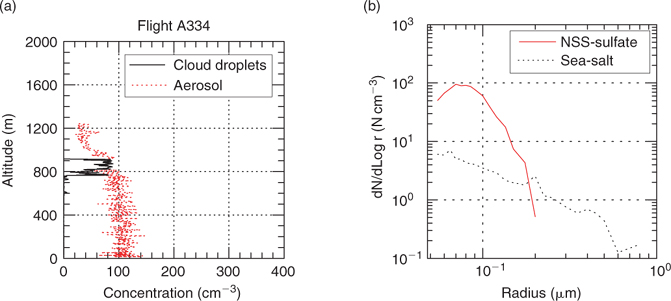Sea-salt particles and the CLAW hypothesis
Michael H. SmithSchool of Earth and Environment, University of Leeds, Leeds LS2 9JT, UK. Email: m.h.smith@leeds.ac.uk
Environmental Chemistry 4(6) 391-395 https://doi.org/10.1071/EN07071
Submitted: 27 September 2007 Accepted: 4 November 2007 Published: 6 December 2007
Environmental context. When proposing that dimethyl sulfide (DMS) releases from phytoplankton had a role in regulating the global climate, the potential parallel influences of sea spray aerosols on climate were largely disregarded. Over the intervening 20 years, scientific studies have clearly demonstrated a substantial role for sea spray particles in modifying cloud properties and influencing global sulfur cycling, diminishing the significance of the DMS-based CLAW mechanism.
Introduction
In 1987, the CLAW[1] paper extended a speculative hypothesis first proposed by Shaw[2] that life on Earth could provide a negative feedback link which would help to stabilise the climate. This mechanism, described in detail by Ayers and Cainey,[3] relies on the formation of non-sea-salt sulfate (NSS-sulfate) aerosol particles that, in turn, influence cloud albedo by their action as cloud condensation nuclei (CCN). This mechanism became linked almost immediately with the Gaia hypothesis – the idea of a self-regulating Earth (initially via the medium of CO2 levels) – and, though Lovelock[4] never asserted that the hypothesis had a teleological significance, less scientific elements endeavoured to attach a mystical meaning to it. The debate – scientific and otherwise – continues to the present day.
From the beginning, my interest and concerns focussed on the point that, though there was no doubt that plankton in the global oceans are a large source of dimethyl sulfide (DMS) and provide the largest natural source of sulfur to the atmosphere, the complex web of inter-relationships that link atmospheric trace gases to aerosol particles, CCN, cloud droplets and the global climate were much less well understood. There was a need for counter-balancing consideration of the multitude of other trace gases and aerosol particulates within the atmospheric system.[5] For example, at an early stage, it was pointed out that the dominance of anthropogenic sulfur emissions in the northern hemisphere should result in brighter clouds relative to the less-polluted southern hemisphere, because the atmospheric pathways of natural and anthropogenic sulfur should be similar.[6] However, no such differences were found in satellite observations.[7] Furthermore, theoretical and observational studies[8,9] indicate that the formation of new aerosol particles commonly takes place in the free troposphere, where they age before being entrained into the boundary layer. These results greatly complicate the CLAW mechanism without negating it.
More specifically, I was struck by how the potential role of sea-salt particles – a dominant aerosol component in the natural global system – was almost totally overlooked. This point was made in an early response to the CLAW paper by Blanchard and Cipriano[10] but, taken with the reply,[11] served mainly to emphasise the need for a much more thorough investigation of the role of sea salt in cloud microphysics and the global climate. This need served to stimulate in me a much broader view of the role of sea spray in the global climate, going beyond earlier interests in the larger sea spray particles on atmospheric propagation and their role in heat, momentum and moisture fluxes between the ocean and atmosphere. Within this short article, it is impossible to provide a comprehensive overview of this subject, for which I refer the readers to the excellent recent book by Lewis and Schwartz,[12] and this note is restricted to a personal perspective.
Sea-salt aerosol
The general consensus regarding the impact of sea-salt aerosol particles on the global climate in the years following the CLAW publication may be summarised simply: sea spray particles were too large, too few in number, only found close to the ocean surface and, thus, could have only an insignificant impact on the majority of the global cloud cover. This view seemed to prevail for several years despite substantial contradictory evidence within the scientific literature, prompting myself and my colleagues to renewed investigations on these points.
Small sea-salt particles
Despite the clear evidence in the open literature to the contrary,[13–15] it was generally assumed that, in addition to being few in number, sea-salt particles were confined to sizes above a few micrometres, perhaps because the earliest Woodcock[16] measurements were incapable of resolving smaller particles. Accordingly, my colleagues and I took the opportunity of a North Atlantic cruise to deploy an improved high-temperature volatility system,[17] capable of distinguishing sea salt, sulfate and other components of the submicron aerosol over the relatively remote ocean. These observations[18,19] clearly indicated a wind-speed dependence of sea-salt particles that was similar across all particles sizes (down to 0.15 µm) detected by the Particle Measuring Systems ASASP-X particle counter (Particle Measuring Systems, Boulder, CO, USA), as shown in Fig. 1. At the typical wind speeds encountered during the cruise, concentrations of these submicron particles were found to be between 10 and 100 cm–3 and thus capable of a significant influence on cloud microphysical properties.

|
A further intriguing point was that the sulfate particles were found to have a wind-speed dependency over the same particle sizes ranges, as shown in Fig. 2. However, in contrast to the sea-salt particles, this wind speed relationship was strongest for the larger particles (approaching 1 µm) in size, rather than for the smallest particles most likely to be influenced by a DMS flux. Following Sievering et al.,[20] this effect was attributed to these particles being a heterogeneous mixture of sea salt and captured sulfate precursors, raising the prospect of sea spray aerosol being a significant moderator of oceanic sulfur fluxes.
More recent work has demonstrated that the bubble bursting inherent in the whitecap production of sea spray aerosols can produce particles as small as 10 nm or so,[21–23] with some studies demonstrating the presence of substantial organic fractions in these submicron particles.[24,25]
Sea-salt particles at cloud base – contributions to cloud condensation nuclei
Having established the presence of substantial numbers of sea-salt particles with sizes that would be effective as CCN, our attention shifted to the issue of whether these particles were available at cloud base. Again, this issue had been addressed by Woodcock[16] decades earlier, who also noted that, on occasions, there was a peak in sea-salt particle concentrations immediately below cumulus cloud base around Hawaii. By adapting our volatility system for airborne use, the presence and concentrations of sea-salt CCN just below cloud base could be established. A series of flights utilising the UK Meteorological Office C-130 aircraft were undertaken over the NE Atlantic and NE Pacific Oceans in the presence of marine stratocumulus clouds.[26] Aerosol measurements were taken at various heights below cloud and associated cloud droplet measurements were recorded above cloud base. Two case studies were highlighted in this work – one for low wind conditions over the Pacific shown in Fig. 3, the other for high wind conditions over the NE Atlantic shown in Fig. 4. Fig. 3a shows that subcloud aerosol concentrations were relatively low and that almost all of these particles were activated in cloud, with the volatility results in Fig. 3b indicating that the overwhelming majority of particles were NSS-sulfate.

|
In Fig. 4a, the subcloud aerosol concentrations were ~250 cm–3, and well mixed throughout the surface layer, but the volatility results (Fig. 4b) indicated a much greater proportion (~30%) consisted of sea-salt particles. In this case, much lower cloud droplet concentrations of ~50 cm–3 were recorded. Further analysis and modelling of the results from these studies strongly suggested that, in the high wind case, the larger, more hygroscopic sea-salt CCN were suppressing the activation of the more numerous sulfate particles.
In addition to demonstrating the presence of sea-salt CCN at cloud base, the above work showed that the simple monotonic relationships between subcloud aerosol particles and the resulting cloud droplet concentrations previously employed in many climate models[27–29] were inadequate to describe the response of marine stratocumulus to aerosols of mixed composition.
Activation of internally and externally mixed aerosols in clouds
The work described above – and many similar studies around the world – prompted the development of numerous aerosol activation models designed to investigate the activation of aerosol particles into cloud droplets.[30–35] All of these models serve to indicate the complex inter-relationships between aerosol particles of differing sizes and composition during the cloud droplet activation process. These complex interactions are the main reason why the indirect aerosol effect remains one of the key uncertainties regarding the impact of aerosol particles on the global climate.
One of the most recent studies[36] includes biomass smoke plus sea-salt and NSS-sulfate particles in the aerosol mix and illustrates the complex and often non-linear dependence of cloud droplet number on aerosol mass. In this study, the sulfate particles are the most effective in increasing droplet concentrations but, at high sea-salt levels, increasing the biomass smoke contribution beyond a level of ~1.5 µg m–3 leads to a substantial fall in activated cloud droplets.
A further point illustrated by these and other models is the propensity for cloud droplets to act as ‘factories’ for the conversion of sulfate precursor gases into additional sulfate material. The sea-salt particles were especially effective in this process owing to their greater size and higher alkalinity[37,38] and are likely to be the primary chemical sink for SO2 in the cloudy marine boundary layer.
Conclusions
The intervening 20 years have done little to quiet the controversy surrounding the CLAW hypothesis; indeed, if anything the situation has become more complex. Vallina and Simó[39] have indicated a strong correlation between DMS concentrations in the upper ocean and the solar radiation dose, which supports one of the tenets of the CLAW hypothesis, namely that increased solar radiation will enhance the DMS flux. However, whether this enhanced DMS flux results in a negative feedback via an impact on the cloud albedo remains an open question.
Recent work by Yoon and Brimblecombe[40] emphasises that sea-salt aerosols have a major role in marine CCN production and that the main control on marine boundary layer CCN concentration, and hence the indirect radiative effect, may be surface wind speed, which has a strong influence on both sea-salt particle production and the DMS flux. The authors suggest that this process could be more efficient than the CLAW mechanism, which focussed on DMS fluxes resulting from temperature changes.
Improved modelling and measurement approaches to sea-salt particle production have led to more accurate assessments of particle fluxes and extended these flux measurements to smaller aerosol sizes.[41–43] Furthermore, the development of new instrumentation offers the prospect of much-needed observations of sea-salt fluxes under high wind conditions (M. K. Hill et al., unpubl. data).
Although this paper has concentrated on the role of sea-salt particles in influencing the concentration of cloud droplets, and thereby the cloud albedo, the influence of cloud lifetime on climate change should not be neglected. A recent study of rain formation in shallow cumulus based on data gathered during the Rain In Cumulus over the Ocean (RICO) project conducted in the Caribbean, suggested that giant (dry sizes from 1 to 10 µm) and ultra-giant (dry sizes >10 µm) aerosol particles (overwhelmingly sea salt) were present in sufficient concentrations to explain rainfall formation within the observed time scales.[44] Furthermore, modelling studies suggested that this rainfall formation was insensitive to cloud droplet concentration over the range observed in these maritime clouds.
Finally, in addition to the role of sea salt in global climate processes becoming more strongly established over this period, with observations of smaller and more numerous particles, there are the discovery of new particle formation processes in coastal and many other rural and urban locations,[45–47] and the roles of biogenic gases and particles.[48] These processes operate alongside the DMS sulfur cycle. Thus, a key component of the hypothesis, namely, that DMS-derived sulfate particles have the capability of regulating cloud cover and the global climate, remains dubious.

|
Acknowledgements
I offer grateful thanks to all the colleagues, too numerous to cite individually, who have contributed to the work described above. A special acknowledgement is due to Martin Hill, whose innovative and incisive solutions to technical and scientific problems made a vital, and occasionally unrecognised, contribution to the field work. Also, I am grateful for the helpful comments made by the reviewers of this paper.
[1]
R. J. Charlson ,
J. E. Lovelock ,
M. O. Andreae ,
S. G. Warren ,
Oceanic phytoplankton, atmospheric sulphur, cloud albedo and climate.
Nature 1987
, 326, 655.
| Crossref | GoogleScholarGoogle Scholar |

[2]
G. E. Shaw ,
Bio-controlled thermostasis involving the sulfur cycle.
Clim. Change 1983
, 5, 297.
| Crossref | GoogleScholarGoogle Scholar |

[3]
G. Ayers ,
J. M. Cainey ,
The CLAW hypothesis: a review of the major developments.
Environ. Chem. 2007
, 4, 366.
| Crossref | GoogleScholarGoogle Scholar |

[4]
J. E. Lovelock ,
Hands up for the Gaia hypothesis.
Nature 1990
, 344, 100.
| Crossref | GoogleScholarGoogle Scholar |

[5]
[6]
A. Slingo ,
Can plankton control climate?
Nature 1988
, 336, 421.
| Crossref | GoogleScholarGoogle Scholar |

[7]
S. E. Schwartz ,
Are global cloud albedo and climate controlled by marine phytoplankton?
Nature 1988
, 336, 441.
| Crossref | GoogleScholarGoogle Scholar |

[8]
F. Raes ,
Entrainment of free tropospheric aerosols as a regulating mechanism for cloud condensation nuclei in the remote marine boundary layer.
J. Geophys. Res. 1995
, 100, 2893.
| Crossref | GoogleScholarGoogle Scholar |

[9]
A. D. Clarke ,
J. L. Varner ,
F. Eisele ,
R. L. Maudlin ,
D. Tanner ,
M. Litchy ,
Particle production in the remote marine atmosphere: cloud outflow and subsidence during ACE-1.
J. Geophys. Res. 1998
, 103(D13), 16397.
| Crossref | GoogleScholarGoogle Scholar |

[10]
D. C. Blanchard ,
R. J. Cipriano ,
Biological regulation of climate.
Nature 1987
, 330, 526.
| Crossref | GoogleScholarGoogle Scholar | PubMed |

[11]
R. J. Charlson ,
S. G. Warren ,
Biological regulation of climate – reply.
Nature 1987
, 330, 526.
| Crossref | GoogleScholarGoogle Scholar | PubMed |

[12]
[13]
A. H. Woodcock ,
Smaller salt particles in oceanic air and bubble behaviour in sea.
J. Geophys. Res. 1972
, 77, 5316.

[14]
A. Mészáros ,
K. Vissy, Concentration, size distribution and chemical nature of atmospheric aerosol particles in remote oceanic areas.
J. Aerosol Sci. 1974
, 5, 101.
| Crossref | GoogleScholarGoogle Scholar |

[15]
R. J. Cipriano ,
E. C. Monahan ,
P. A. Bowyer ,
D. K. Woolf ,
Marine condensation nucleus generation inferred from whitecap simulation tank results.
J. Geophys. Res. 1987
, 92, 6569.

[16]
A. H. Woodcock ,
Salt nuclei in marine air as a function of altitude and wind force.
J. Meteorol. 1953
, 10, 362.

[17]
C. D. O’Dowd ,
S. G. Jennings ,
M. H. Smith ,
W. Cooke ,
A high temperature volatility technique for determination of atmospheric aerosol composition.
J. Aerosol Sci. 1992
, 23, 905.
| Crossref | GoogleScholarGoogle Scholar |

[18]
C. D. O’Dowd ,
M. H. Smith ,
S. G. Jennings ,
Submicron particle, radon and soot carbon characteristics over the North-east Atlantic.
J. Geophys. Res. 1993
, 98, 1123.

[19]
C. D. O’Dowd ,
M. H. Smith ,
Physico-chemical properties of aerosols over the North-east Atlantic: evidence for wind-speed-related submicron sea-salt aerosol production.
J. Geophys. Res. 1993
, 98, 1137.

[20]
H. Sievering ,
J. Boatman ,
J. Galloway ,
W. Keene ,
Y. Kim ,
M. Luria ,
J. Ray ,
Hetereogeneous sulphur conversion in sea-salt aerosol particles: the role of aerosol water content and size distribution.
Atmos. Environ. 1991
, 25, 1479.

[21]
E. M. Mårtensson ,
E. D. Nilsson ,
G. De Leeuw ,
L. H. Cohen ,
H.-C. Hansson ,
Laboratory simulations and parameterization of the primary marine aerosol production.
J. Geophys. Res. 2003
, 108, 4297.
| Crossref | GoogleScholarGoogle Scholar |

[22]
M. Geever ,
C. D. O’Dowd ,
J. S. van Ekeren ,
R. Flanagan ,
E. D. Nilsson ,
G. De Leeuw ,
U. Rannik ,
Submicron sea spray fluxes.
Geophys. Res. Lett. 2005
, 32, L15810.
| Crossref | GoogleScholarGoogle Scholar |

[23]
A. D. Clarke ,
S. R. Owens ,
J. Zhou ,
An ultrafine sea-salt flux from breaking waves: implications for cloud condensation nuclei in the remote marine atmosphere.
J. Geophys. Res. 2006
, 111, D06202.
| Crossref | GoogleScholarGoogle Scholar |

[24]
A. M. Middlebrook ,
D. M. Murphy ,
D. S. Thomson ,
Observations of organic material in individual marine particles at Cape Grim during the First Aerosol Characterization Experiment (ACE-1).
J. Geophys. Res. 1998
, 103, 16475.
| Crossref | GoogleScholarGoogle Scholar |

[25]
F. Cavalli ,
M. C. Facchini ,
S. Decesari ,
M. Mircea ,
L. Emblicia ,
S. Fuzzi ,
D. Ceburnis ,
Y. J. Yoon ,
et al. Advances in characterization of size-resolved organic matter in marine aerosol over the North Atlantic.
J. Geophys. Res. 2004
, 109, D24215.
| Crossref | GoogleScholarGoogle Scholar |

[26]
C. D. O’Dowd ,
J. A. Lowe ,
M. H. Smith ,
A. D. Kaye ,
The relative importance of non-sea-salt sulphate and sea-salt aerosol to the marine cloud condensation nuclei population: an improved multi-component aerosol–cloud droplet parameterization.
Q. J. R. Meteorol. Soc. 1999
, 125, 1295.
| Crossref | GoogleScholarGoogle Scholar |

[27]
A. Jones ,
D. L. Roberts ,
A. Slingo ,
A climate model study of indirect radiative forcing by anthropogenic sulphate aerosols.
Nature 1994
, 370, 450.
| Crossref | GoogleScholarGoogle Scholar |

[28]
D. A. Hegg ,
S. A. Rutledge ,
P. V. Hobbs ,
A numerical model for sulphur chemistry in warm-frontal rainbands.
J. Geophys. Res. 1984
, 89, 7133.

[29]
O. Boucher ,
U. Lohmann ,
The sulfate–CCN–cloud albedo effect – a sensitivity study with 2 general-circulation models.
Tellus B 1995
, 47, 281.
| Crossref | GoogleScholarGoogle Scholar |

[30]
S. Ghan ,
G. Guzman ,
H. Abdul-Razzak ,
Competition between sea salt and sulfate particles as cloud condensation nuclei.
J. Atmos. Sci. 1998
, 55, 3340.
| Crossref | GoogleScholarGoogle Scholar |

[31]
C. D. O’Dowd ,
J. A. Lowe ,
M. H. Smith ,
Observations and modelling of aerosol growth in marine stratocumulus.
Atmos. Environ. 1999
, 33, 3053.
| Crossref | GoogleScholarGoogle Scholar |

[32]
C. Fountoukis ,
A. Nenes ,
Continued development of a cloud droplet formation parameterization for global climate models.
J. Geophys. Res. 2005
, 110, D11212.
| Crossref | GoogleScholarGoogle Scholar |

[33]
S. Ghosh ,
S. Osborne ,
M. H. Smith ,
On the importance of cumulus penetration on the microphysical and optical properties of stratocumulus clouds.
Atmos. Chem. Phys. 2005
, 5, 755.

[34]
G. J. Roelofs ,
P. Stier ,
J. Feichter ,
E. Vignati ,
J. Wilson ,
Aerosol activation and cloud processing in the global aerosol-climate model ECHAM5-HAM.
Atmos. Chem. Phys. 2006
, 6, 2389.

[35]
J. R. Pierce ,
P. J. Adams ,
Global evaluation of CCN formation by direct emission of sea salt and growth of ultrafine sea salt.
J. Geophys. Res. 2006
, 111, D06203.
| Crossref | GoogleScholarGoogle Scholar |

[36]
S. Ghosh ,
M. H. Smith ,
A. Rap ,
Integrating biomass, sulphate and sea-salt aerosol responses into a microphysical chemical parcel model: implications for climate studies.
Philos. T. Roy. Soc. A 2007
, 365, 2659.
| Crossref | GoogleScholarGoogle Scholar |

[37]
C. D. O’Dowd ,
J. A. Lowe ,
M. H. Smith ,
Coupling of sea-salt and sulphate interactions and its impact on cloud droplet concentration predictions.
Geophys. Res. Lett. 1999
, 26, 1311.
| Crossref | GoogleScholarGoogle Scholar |

[38]
C. D. O’Dowd ,
J. A. Lowe ,
N. A. Clegg ,
M. H. Smith ,
S. L. Clegg ,
Modelling heterogeneous sulphate production in maritime stratiform clouds.
J. Geophys. Res. 2000
, 105, 7143.
| Crossref | GoogleScholarGoogle Scholar |

[39]
S. M. Vallina ,
R. Simó ,
Strong relationship between DMS and the solar radiation dose over the global surface ocean.
Science 2007
, 315, 506.
| Crossref | GoogleScholarGoogle Scholar | PubMed |

[40]
Y. J. Yoon ,
P. Brimblecombe ,
Modelling the contribution of sea salt and dimethyl sulfide-derived aerosol to marine CCN.
Atmos. Chem. Phys. 2002
, 2, 17.

[41]
J. S. Reid ,
H. H. Jonsson ,
M. H. Smith ,
A. Smirnov ,
Evolution of the vertical profile and flux of large sea-salt particles in a coastal zone.
J. Geophys. Res. 2001
, 106, 12039.
| Crossref | GoogleScholarGoogle Scholar |

[42]
S. Norris ,
I. Brooks ,
G. de Leeuw ,
M. H. Smith ,
M. Moerman ,
J. Lingard ,
Eddy covariance measurements of sea spray particles over the Atlantic Ocean.
Atmos. Chem. Phys. Discuss. 2007
, 7, 13243.

[43]
E. D. Nilsson ,
E. M. Mårtensson ,
J. S. van Ekeren ,
G. de Leeuw ,
M. Moerman ,
C. D. O’Dowd ,
Primary marine aerosol emissions: size-resolved eddy covariance measurements with estimates of the sea salt and organic carbon fractions.
Atmos. Chem. Phys. Discuss. 2007
, 7, 13345.

[44]
[45]
C. D. O’Dowd ,
G. McFiggans ,
D. J. Creasey ,
L. Pirjola ,
C. Hoell ,
M. H. Smith ,
B. J. Allen ,
J. M. C. Plane ,
et al. On the photochemical production of new particles in the coastal boundary layer.
Geophys. Res. Lett. 1999
, 26, 1707.
| Crossref | GoogleScholarGoogle Scholar |

[46]
M. Kulmala ,
K. Hameri ,
P. P. Aalto ,
J. M. Makela ,
L. Pirjola ,
E. D. Nilsson ,
G. Buzorius ,
U. Rannik ,
et al. Overview of the international project on biogenic aerosol formation in the boreal forest (BIOFOR).
Tellus B 2001
, 53, 324.
| Crossref | GoogleScholarGoogle Scholar |

[47]
A. Alam ,
J. P. Shi ,
R. M. Harrison ,
Observations of new particle formation in urban air.
J. Geophys. Res. 108, 4093.
| Crossref | GoogleScholarGoogle Scholar |

[48]
C. D. O’Dowd ,
T. Hoffman ,
Coastal new particle formation: a review of the current state-of-the-art.
Environ. Chem. 2005
, 2, 245.
| Crossref | GoogleScholarGoogle Scholar |





